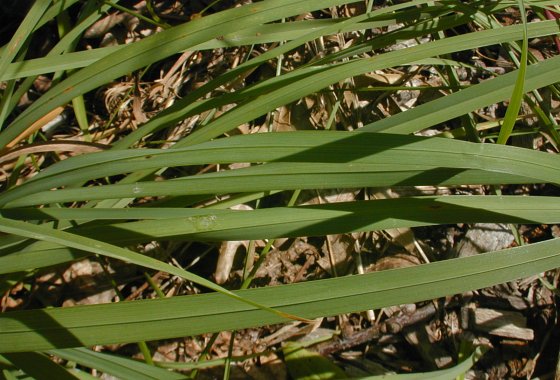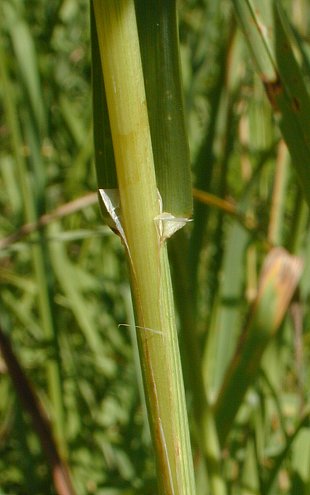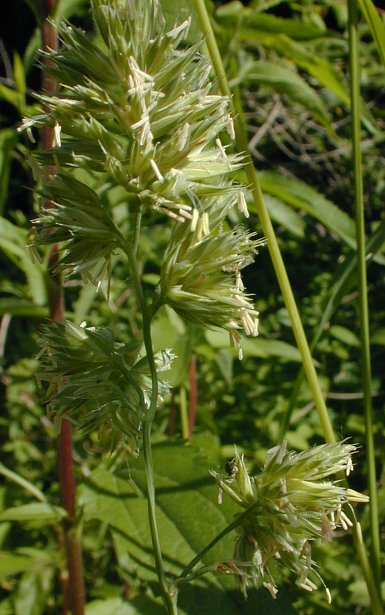Description: This perennial grass is 3-6' tall at maturity. Infertile shoots produce low dense tufts of leaves, while fertile shoots produce tall culms with alternate leaves. Each culm terminates in an inflorescence on a long naked stalk. The culms are light green, terete, and glabrous; later they become straw-colored (stramineous). The leaves of both fertile and infertile shoots have a similar appearance. Their blades are up to 10" long and 1/3" (8 mm.) across; they are green and hairless. The leaf blades of infertile shoots spread outward and remain low, while the blades of alternate leaves on fertile shoots are more arching. The leaf sheaths are light green, hairless, and open toward their apices; they have longitudinal veins. The ligules have long papery membranes (up to 10 mm. in length) that become more or less shredded with age. The inflorescence consists of a panicle of spikelets; the branching pattern of this panicle tends to occur along a 2-dimensional plane. The panicle is up to 10" long and 5" across, consisting of an erect rachis and short lateral branches (only 1 lateral branch per node); the latter are stiff, straight, spreading to nearly erect, and few in number. Lateral branches have dense tufts of spikelets toward their tips, otherwise they are naked. The rachis also terminates in dense tufts of spikelets.

Each spikelet consists of a dense tuft of 3-7 lemmas and their perfect florets; there is a pair of sterile glumes at the bottom. The spikelets are whitish green while their florets are blooming, but they later become light tan to brown. The glumes are linear-lanceolate, keeled, and unequal in size; the shorter glume of a pair is about 4-5 mm. in length, while the longer glume is about 5-6 mm. in length. The lemmas are linear-lanceolate and ciliate along their keels; they are about 5-8 mm. in length. In each spikelet, the upper lemmas tend to be shorter than the lower lemmas. Each floret has a pair of white plumose stigmata and 3 stamens with large white anthers. The blooming period occurs from late spring to mid-summer, lasting about 1-2 weeks for a colony of plants. The florets are cross-pollinated by the wind. Individual grains are about 2.5-3.0 mm. long and 1.0 mm. across; they are narrowly ellipsoid-lanceoloid, concave along one side, and light tan. The root system consists of short rhizomes and fibrous roots.

Cultivation:
The
preference is partial sun, mesic conditions, and fertile soil
containing loam, clay-loam, or gravelly loam. This robust grass also
grows readily in
full sun and moist or slightly dry conditions. It is rather aggressive,
but doesn't tolerate regular mowing.
Range & Habitat:
This common grass occurs in every county of Illinois (see Distribution
Map). It was introduced into North America from Europe as a
source of hay and
pasturage. Habitats include savannas, woodland borders, thickets,
disturbed meadows in wooded areas, powerline clearances in wooded
areas, fence rows, old fields and pastures, orchards, and miscellaneous
waste areas. Areas with a history of disturbance are preferred.

Faunal Associations: Various insects feed on the leaves, roots, and other parts of Orchard Grass. These species include Chortophaga viridifasciata (Green-striped Grasshopper) and other grasshoppers, Chaetocnema denticulata (Toothed Flea Beetle) and Chaetocnema pulicaria (Corn Flea Beetle), Oulema melanopus (Cereal Leaf Beetle), larvae of the fly Cerodontha dorsalis (Grass Sheath Miner), larvae of the moths Leucania inermis (Unarmed Wainscot) and Leucania multilinea (Many-lined Wainscot), larvae of the butterfly Megisto cymela (Little Wood Satyr), Hyalopteroides humilis (Orchard Grass Aphid) and other aphids, and Stenotus binotatus (Two-Spotted Grass Bug). See the Insect Table for a more complete listing of these species. Among vertebrate animals, the seeds of Orchard Grass are eaten sparingly by some granivorous songbirds, including the Horned Lark and Chipping Sparrow. Hoofed mammalian herbivores (primarily livestock) graze on Orchard Grass; young foliage is especially palatable to them. Because Orchard Grass is fairly tall and robust, it has a tendency to form colonies that provide cover for small mammals, snakes, insects, and other wildlife.

Photographic
Location: A
powerline clearance at Busey Woods in Urbana, Illinois.
Comments:
Orchard Grass develops early and becomes tall; it usually blooms by
early summer. At this time of year, it can be identified by the stiff
lower branches of its panicles; each of these lower branches forms an
angle of 90° or less with the central rachis of the inflorescence.
Furthermore, branches of its panicles have dense clusters of
spikelets toward their tips, otherwise they are naked. Both the glumes
and lemmas are rather long (5-8 mm.) and they are usually ciliate along
their keels. The foliage of Orchard Grass is hairless and its ligules
have long papery membranes that are often shredded. These various
characteristics are especially useful in identifying this grass
correctly. Orchard Grass is the only species of its genus in Illinois.